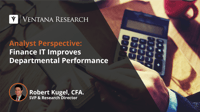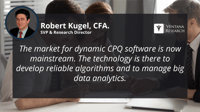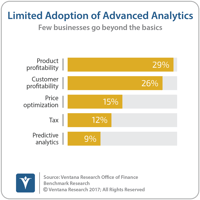Environmental, social and governance reporting by public corporations has become a top-of-mind issue for senior executives and boards of directors as countries increasingly consider or mandate its implementation in some form. The fundamental rationale for ESG reporting is rooted in the inability of purely financial measures to capture externalities (such as greenhouse gas emissions) or provide metrics that enable an objective assessment of management’s ability to properly determine trade-offs...
Read More
Topics:
Human Capital Management,
Office of Finance,
Business Intelligence,
Data Governance,
Data Preparation,
Data,
Financial Performance Management,
ERP and Continuous Accounting
A year of business uncertainty, lockdowns and operational disruptions forced finance and accounting organizations to adapt and change in many ways that are proving to be permanent. The need to operate virtually resulted in some organizations accelerating their adoption of technology, bringing them closer to achieving a transformation of the finance and accounting function: reshaping the department into an organization that is more forward-looking and strategic. Strategic in the sense of...
Read More
Topics:
Office of Finance,
Business Intelligence,
Data Governance,
Data Preparation,
Business Planning,
Financial Performance Management,
ERP and Continuous Accounting,
blockchain,
robotic finance,
Predictive Planning,
AI & Machine Learning
Configure, price and quote (CPQ) software has been around for decades. Lately, I’ve been using the term “Dynamic CPQ” to apply to a variant of this software category that explicitly aims to produce a quote that optimizes the trade-off between the profitability of a deal and the probability of closing a sale. Dynamic CPQ software is a hybrid of price and revenue optimization (PRO) software and CPQ, providing companies with the ability to better execute their market share and pricing strategies....
Read More
Topics:
Customer Experience,
Office of Finance,
Data Preparation,
Information Management,
Sales Performance Management,
Financial Performance Management,
Price and Revenue Management,
robotic finance,
revenue and lease accounting,
sales enablement
By itself, data isn’t useful for business; the application of analytics is necessary to transform data into actionable information. Data analysis of one sort or another has long been a core competence of finance departments, applied to balance sheets, income statements or cash flow statements. Today, however, Finance must go beyond these basics by expanding the scope of the data being examined to include all financial and operational information that can yield actionable insights. Analysis thus...
Read More
Topics:
Customer Experience,
Human Capital Management,
Marketing,
Voice of the Customer,
business intelligence,
embedded analytics,
Learning Management,
Analytics,
Collaboration,
Data Governance,
Data Lake,
Data Preparation,
Information Management,
Internet of Things,
Contact Center,
Data,
Product Information Management,
Sales Performance Management,
Workforce Management,
Financial Performance Management,
Price and Revenue Management,
Digital Technology,
Digital Marketing,
Digital Commerce,
ERP and Continuous Accounting,
blockchain,
natural language processing,
robotic finance,
Predictive Planning,
candidate engagement,
Intelligent CX,
Conversational Computing,
Continuous Payroll,
revenue and lease accounting,
collaborative computing,
mobile computing,
Subscription Management,
agent management,
extended reality,
AI & Machine Learning
Workiva recently introduced Wdata, a cloud facility for centralizing financial and non-financial information from multiple sources. It frees up time for finance organizations, especially financial planning and analysis (FP&A) groups, to explore conditions and trends in their business because they need to spend less of it gathering data and preparing it for analysis and reporting. Ventana Research recently awarded Workiva our Digital Innovation award for Wdata because of its transformative...
Read More
Topics:
Office of Finance,
Recurring Revenue,
Continuous Planning,
Data Governance,
Data Preparation,
Financial Performance Management,
Price and Revenue Management,
Enterprise Resource Planning,
ERP and Continuous Accounting,
Sales Planning and Analytics,
revenue recognition
PROS Holdings is a software vendor with two distinct but related sets of products. The company began in 1985 offering revenue management software to airlines, hospitality and rental car companies. More recently it added price and revenue management software focusing on B2B services, chemicals and energy, consumer goods manufacturers, food and beverage, healthcare, insurance and technology. This note focuses on the B2B portion of the business.
Read More
Topics:
Big Data,
Sales,
Customer Experience,
Marketing,
Office of Finance,
Analytics,
Data Preparation,
Sales Performance Management,
Financial Performance Management,
Price and Revenue Management,
Digital Marketing,
Digital Commerce,
Pricing and Promotion Management,
Sales Enablement and Execution
Blockchains are attractive because their built-in security and trust factors make them useful for almost all business interactions involving organizations and individuals. Blockchains have two basic functions. One is as a method for handling transactions involving property such as land deeds, trademarks or other assets. The second involves exchanges of data such as identities of individuals or businesses, the location of an object at a point in time or weather conditions. All interactions...
Read More
Topics:
Big Data,
Data Science,
Mobile,
Marketing Performance Management,
Office of Finance,
Analytics,
Business Intelligence,
Cloud Computing,
Data Governance,
Data Integration,
Data Preparation,
Internet of Things,
Digital Technology,
Digital Marketing,
Digital Commerce,
Operations & Supply Chain
















